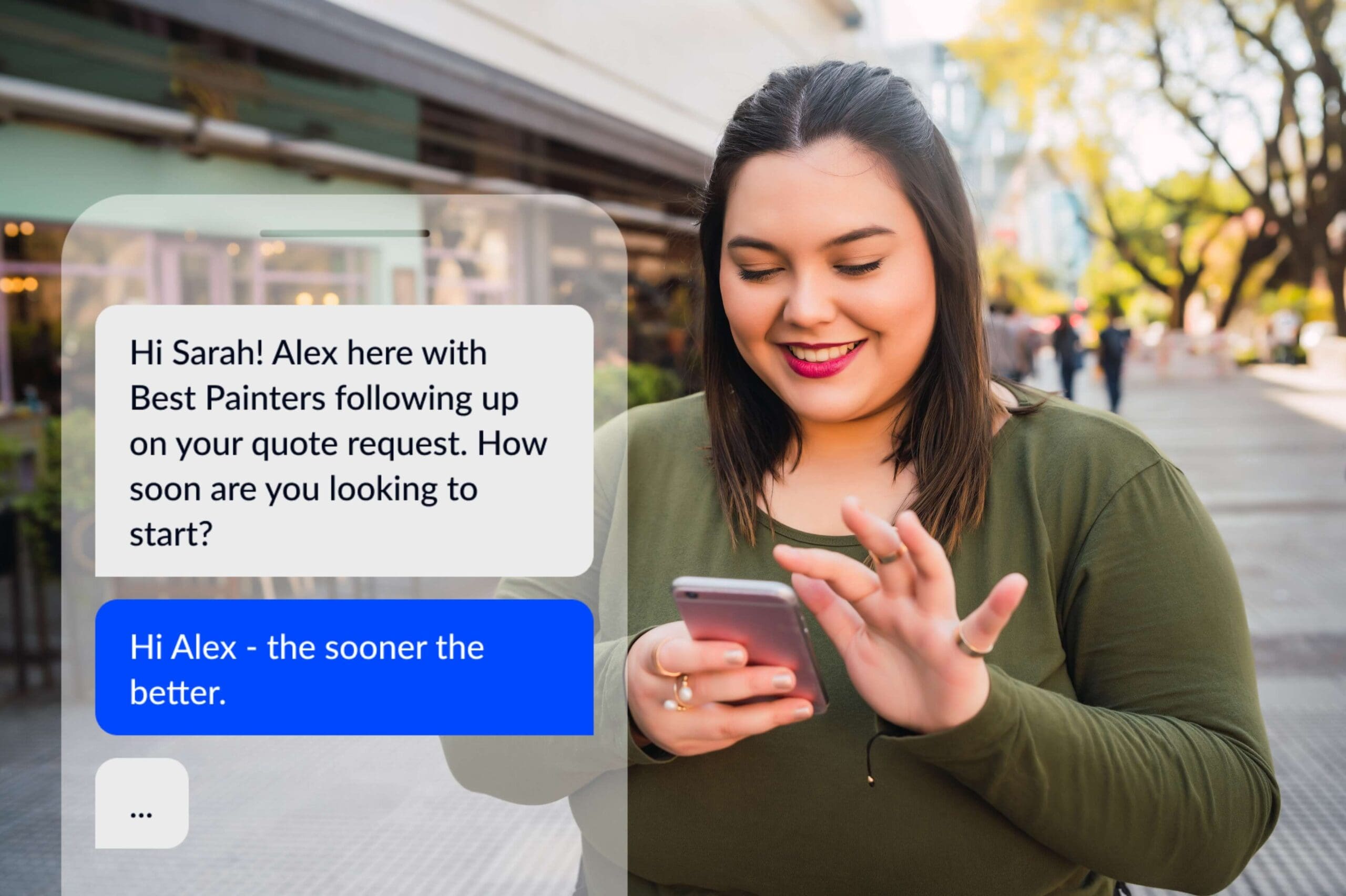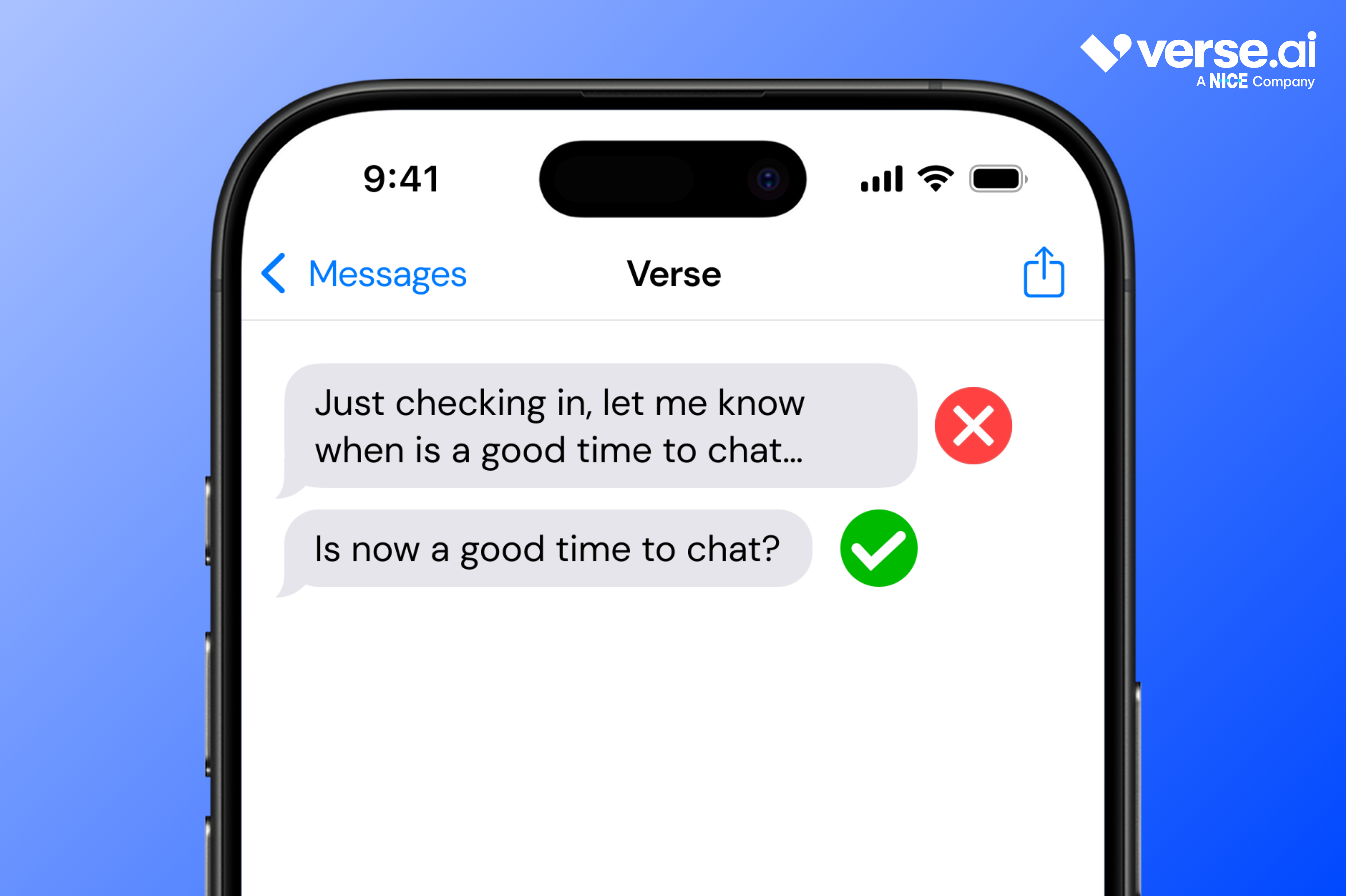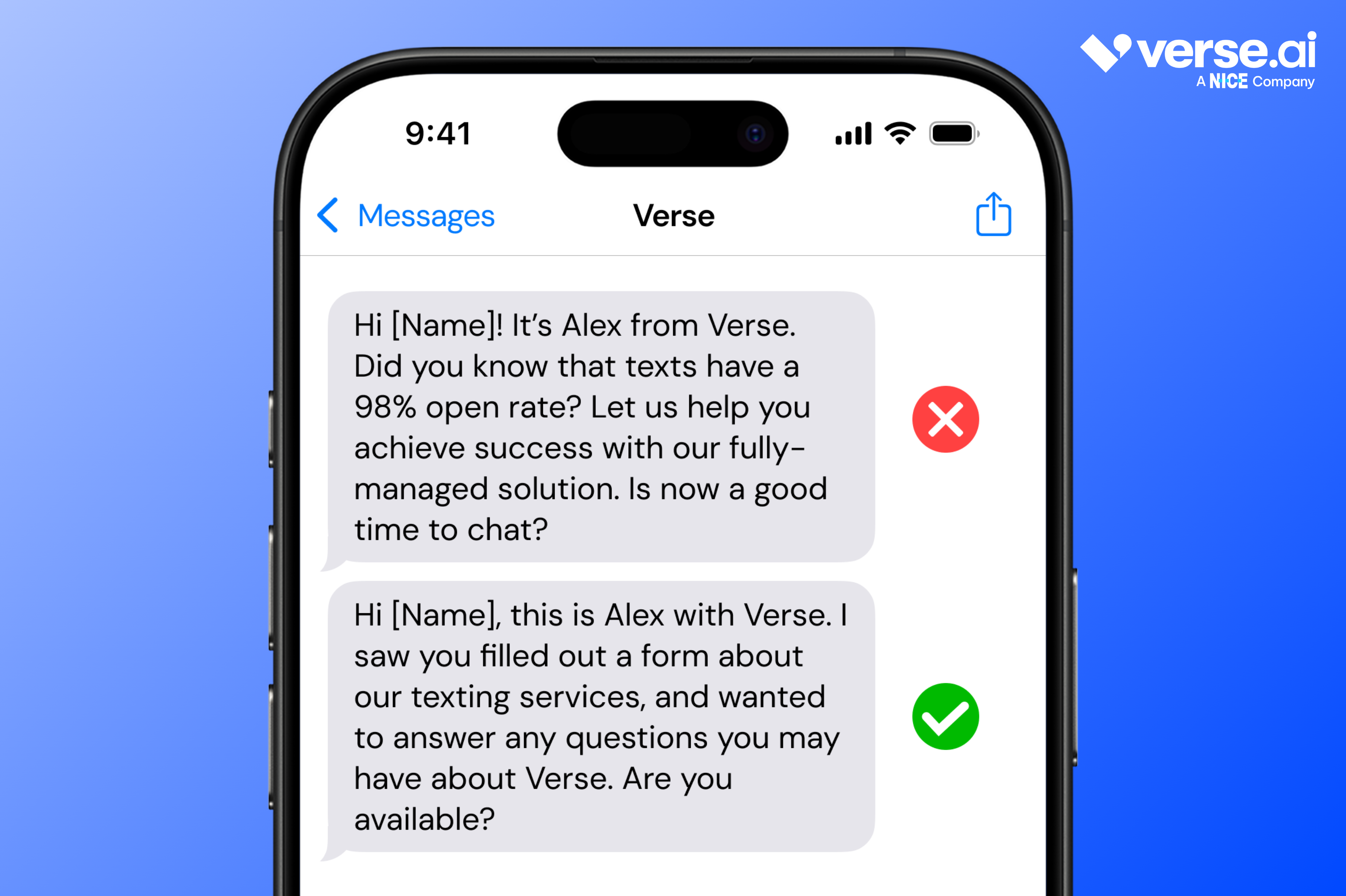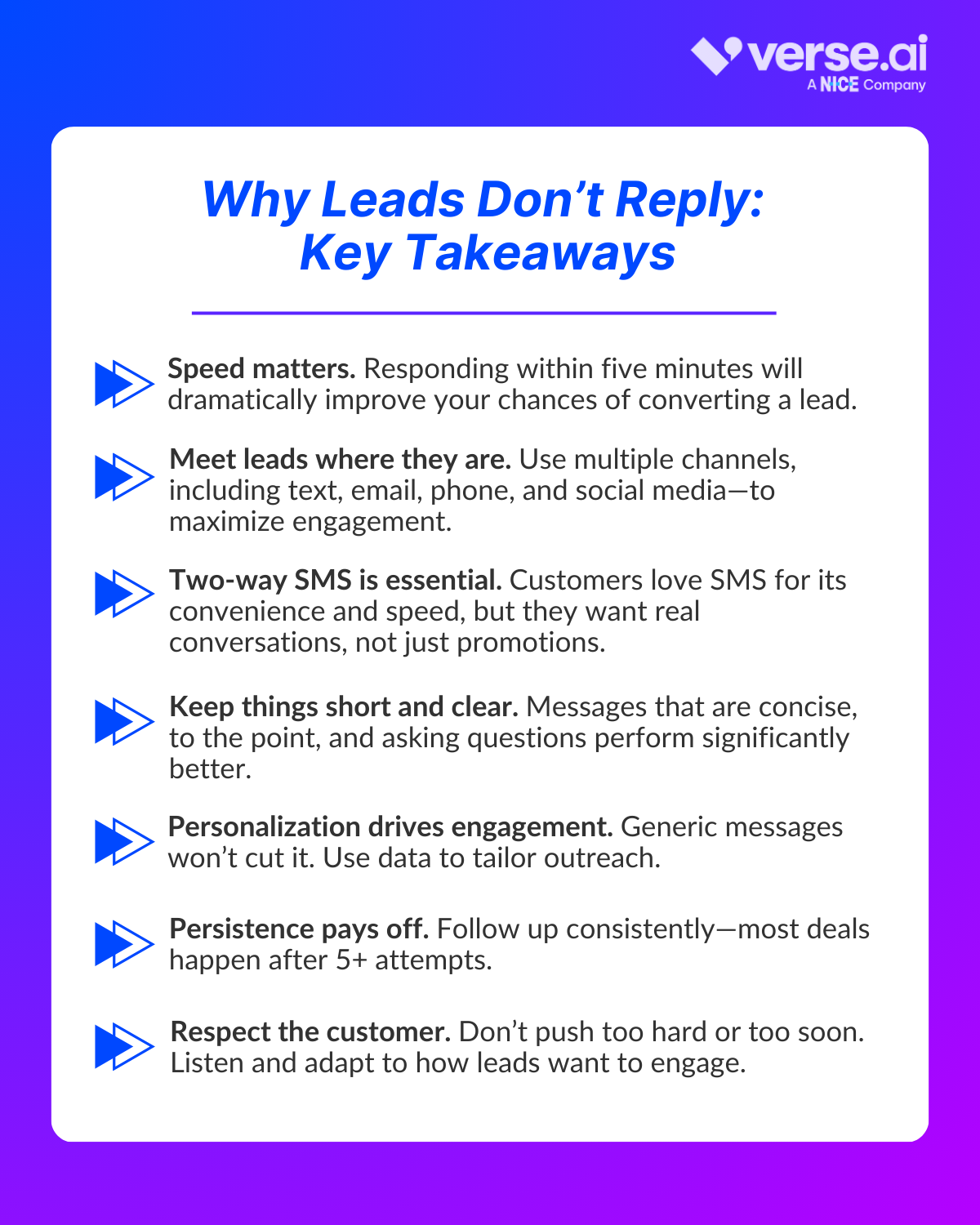How to Boost Lead Reply Rate and Conversions
Are you successfully generating qualified leads, only to have them fill out a form and then ghost you?
Unresponsive leads are silent deal-killers that can turn your investments into a waste.
It can be frustrating to wonder why leads aren’t replying, but you’re not alone in the struggle.
Many businesses spend tons of time and money on generating qualified leads, but can struggle when it comes to engaging those leads. With B2C lead generation costing up to $12,000 per month, this can be an expensive mistake.
What can you do differently to turn qualified leads into closed deals? Let’s talk about common reasons why leads aren’t replying to you, including 8 different errors that are actually silent deal-killers.
Table of Contents
ToggleError 1: Not responding quick enough
Slow response time is one of the biggest deal-killers there is.
Leads do not want to wait for a reply from your business—and data increasingly shows it.
A survey of over 1,900 consumers found that over half of customers hired the first business to respond to their requests, even if it was more expensive.
When it comes to lead response speed, that statistic speaks for itself: if you’re not first, you’re last.
According to HubSpot research, 66% of consumers expect a response from customer service in five minutes or less.
In fact, leads are 21x more likely to convert if they are contacted within five minutes of filling out a form.
As technology advances and the market becomes more crowded, consumer patience is lower than ever. If you don’t reach them when they’re ready to talk, they’ll find another company to help them.
How fast should you reply to leads?
For business lead response time, it seems that five minutes is a great goal.
Regardless of how you might feel about your current lead response time, this is an important metric to measure. Most companies are falling behind when it comes to lead response time.
A study by Harvard Business Review found that among businesses, the average response time was 42 hours—a ways away from five minutes.
It’s also important to keep communication going even during off-hours; 24/7 coverage is becoming increasingly essential.
Error 2: Not using the right channels
If you’re not reaching out on the right channels, you’re less likely to get a response.
When brands meet customers on their preferred channels, they increase the ease and likeliness of a sale.
While emails remain a popular channel for lead outreach, the average professional receives 120 new emails per day—meaning emails often get lost in the noise.
Phone calls can be effective, but only at the right place in the customer journey—and not for every customer. Nowadays, not everyone wants to speak on the phone.
For certain industries, social media can be an effective way to connect with customers. Brands can easily answer questions and have one-on-one conversations via social media, but the channel is more casual. It can be a challenge to take the customer to the next step in the buyer’s journey through social media.
Texting is a fast and convenient way to reach customers wherever they are. With SMS, you can create a personal connection with the customer: qualifying, answering questions, and moving them to the next step in their journey. Text, however, can be an investment-intensive endeavor for companies.
While each channel has its pros and cons, it’s vital to use multiple channels to connect with your audience wherever they are. This can help increase your reply rate and conversion rate.
Error 3: Not using two-way SMS
For many businesses, two-way texting can be a challenge because it requires quick replies, strict compliance, and significant time and investment.
Some businesses opt for one-way SMS for this reason; others don’t text at all.
However, companies that don’t use two-way SMS could be behind the curve for lead engagement, and that can kill deals without them even realizing it.
This is because SMS is consumers’ highest-preferred channel. With 98% read rates, SMS is arguably the best way to get in contact with leads and customers.
Why?
- 90% of texts are read within 30 minutes.
- 78% of people wish they could have a text conversation with a business.
- Coupons received via SMS are redeemed 10 times more often than any medium.
- 66% of consumers would pay more for a service or product if the business had a mobile messaging channel to communicate.
According to Twilio, 85% of consumers want messaging capabilities to be two-way.
In contrast, only 13% of businesses enable two-way SMS.
Though SMS is a convenient way to get in contact, texting should go beyond promotional marketing. Leads want to talk with you, not be talked at.
They want their questions answered; and as much as you want to see if they’re a fit for your business, they want to know that, too. Leads are happy to answer qualifying questions over text, but few businesses take advantage of this.

Error 4: Long or unfocused messages
If companies are using SMS, many are guilty of sending messages that are too long and/or not direct enough.
It’s best to be short and to the point. This goes for email as well.
Verse research has found that shorter texts can boost replies by over 9x compared to longer texts.
It’s always best practice to keep text messages under 320 characters; the briefer and more to-the-point, the better.
In our research, we also found that open-ended messages, especially those referencing “checking in”, perform more poorly than messages that get to the point.
For example, rather than saying:
“Just checking in, let me know when is a good time to chat…”
A message like this will perform better:
“Is now a good time to chat?”

Instead of sending a lengthy text, ask a short question. Make sure the recipient knows what you want from them.
Error 5: Not offering value in communication
In both email and text, it’s dangerous to be overly self-promotional rather than offer value.
If your outreach is too promotional, that could be killing your reply rates.
For marketing and sales teams, it’s best to focus on the customer and what would add value to their experience.
Marketing messaging can be great for spreading awareness about your service or product, but once people are ready to talk, it’s time to use a more human approach.
For example, instead of saying:
“Hi [Name]! It’s Alex from Verse. Did you know that texts have a 98% open rate? Let us help you achieve success with our fully-managed solution. Is now a good time to chat?”
Try something more human and relatable, like:
“Hi [Name], this is Alex with Verse. I saw you filled out a form about our texting services, and wanted to answer any questions you may have about Verse. Are you available?”

Error 6: Not personalizing your approach
Personalization can make or break your lead engagement efforts.
According to McKinsey, 71% of consumers expect personalized interactions from businesses.
Again, don’t send any generic promotional messages or spam pitches.
Utilize whatever data you have on the lead to show that you are paying attention to who they are, what they are interested in, and what they might need: their name, possible pain points, or interests.
If you’ve been taking notes in your customer relationship management platform (CRM), be sure to use any of that information.
Reference any earlier interactions; for example, the resource they accessed or whatever type of request they initially filled out on your website.
Error 7: Giving up too soon
Lack of persistence kills deals. If your leads aren’t replying, maybe you’re not reaching out enough.
Most salespeople give up after one or two attempts without a response; however, research shows that 80% of deals are made after five or more contact attempts.
Six to eight attempts is recommended to try to reach a lead.
So if your leads aren’t replying after the first or second attempt, or even more, that’s not abnormal. It’s the businesses that keep trying that see the eventual payoff.
At the same time, don’t spam your prospects. As mentioned earlier, your goal should still be to offer value and establish a real connection.
For this reason, it’s best to spread attempts out over time—don’t call them more than once a day or text them over three times a day. Create a set schedule for follow-ups and stick to it.
If they don’t reply, try offering something like a helpful resource or a coupon or discount code. You can also spread efforts out over different channels to see where they might reply.
Error 8: Ignoring customer preferences
Sometimes, businesses make the mistake of pushing customer boundaries too much. Not every lead is ready to get on the phone or schedule a meeting right away.
It could be that your leads aren’t replying because you’re not meeting them where they are.
There are several ways to meet customer preferences:
- Ensure that you understand what channels your customers prefer, and prioritize them.
- Ask if they are ready to get on the phone before calling.
- Confirm their serious interest before asking for a meeting off the bat.
Steer away from pushing for a hard appointment too early—this can kill a deal that could’ve happened down the line.
Our research shows it’s most beneficial to engage the lead in a slower manner that is more low-effort for them.
Most importantly, if the lead tells you they are not interested, listen to them. You can always offer to reach out at a later date, even if that’s six months away.
For regulatory compliance, it’s also vital to respect customer communication preferences such as opt-outs or unsubscribes. Texts asking you to stop contact should be treated as an opt-out.
You should never keep trying to contact someone who is trying to opt-out.
Key takeaways: Why leads aren’t replying
Turning your leads into closed deals requires more than just a great product or service—it’s about how and when you engage with them.

Why leads aren’t replying: FAQ
How quickly should I respond to new leads?
Ideally, within five minutes. Research shows that responding in this window makes leads 21x more likely to convert.
What’s the best channel to reach leads?
SMS is consumers’ highest-preferred channel, with 90% of texts read within 30 minutes of receipt. Incorporating text in a multi-channel approach works best. Use SMS, email, phone, and even social media based on your audience’s preferences.
How many times should I follow up with a lead?
Six to eight attempts are ideal. Most deals close after multiple touchpoints, so persistence is key—but spread your attempts over time.
What should I do if a lead isn’t responding?
Try switching channels, adjusting your message, or offering something valuable (like a resource or discount). Make sure your messages are clear and concise.
How do I avoid being too pushy?
Meet the lead where they are. If they aren’t ready for a call, don’t push too soon. Instead, focus on nurturing the relationship and providing value.
Boost lead response with fully-managed, two-way SMS
At Verse, we saw the gap in lead response times and two-way SMS—and we created a solution.
Our fully-managed SMS platform automatically engages and qualifies leads 24/7 using conversational AI and human concierges for quality assurance.
We’ll help you skyrocket your lead reply rates effortlessly with:
- 24/7 instant response via SMS to ensure that every lead is contacted immediately.
- Consistent follow-up for every lead, with customizable, ongoing outreach and nurture for up to six months.
- Automatic lead qualification to help your team focus on high-quality leads.
- Omnichannel communications via text, phone call, and email.
- Compliance assistance and expert guidance.
Ready to learn more about Verse? Let’s chat.


